
The Chinese Civil War was fought between the Kuomintang-led government of the Republic of China and the forces of the Chinese Communist Party (CCP), with armed conflict continuing intermittently from 1 August 1927 until Communist victory resulted in their total control over mainland China on 7 December 1949.
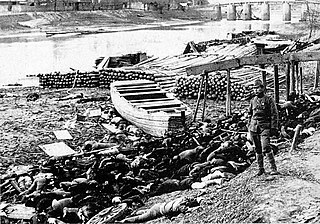
The Nanjing Massacre or the Rape of Nanjing was the mass murder of Chinese civilians in Nanjing, the capital of the Republic of China, immediately after the Battle of Nanking and the retreat of the National Revolutionary Army in the Second Sino-Japanese War, by the Imperial Japanese Army. Beginning on December 13, 1937, the massacre lasted six weeks. The perpetrators also committed other war crimes such as mass rape, looting, torture, and arson. The massacre is considered to be one of the worst wartime atrocities.
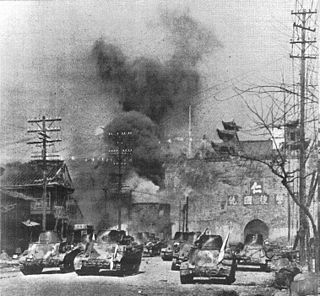
The Battle of Nanking was fought in early December 1937 during the Second Sino-Japanese War between the Chinese National Revolutionary Army and the Imperial Japanese Army for control of Nanjing, the capital of the Republic of China.

The Second Sino-Japanese War was fought between the Republic of China and the Empire of Japan between 1937 and 1945, following a period of war localized to Manchuria that started in 1931. It is considered part of World War II, and often regarded as the beginning of World War II in Asia. It was the largest Asian war in the 20th century and has been described as "the Asian Holocaust", in reference to the scale of Japanese war crimes against Chinese civilians. It is known in China as the War of Resistance against Japanese Aggression.

Inukai Tsuyoshi was a Japanese statesman who was prime minister of Japan from 1931 to his assassination in 1932. At the age of 76, Inukai was Japan's second oldest serving prime minister, after Kantarō Suzuki whose term ended at the age of 77.

The Mukden incident was a false flag event staged by Japanese military personnel as a pretext for the 1931 Japanese invasion of Manchuria.
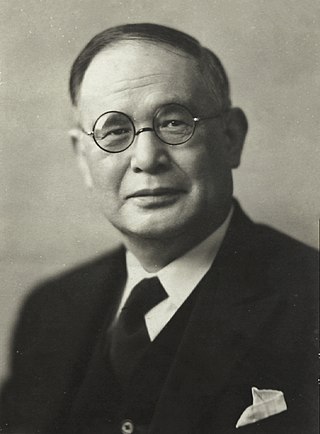
Mamoru Shigemitsu was a Japanese diplomat who served as Minister of Foreign Affairs three times during and after World War II and as Deputy Prime Minister. As a civilian plenipotentiary representing the Japanese government, Shigemitsu cosigned the Japanese Instrument of Surrender on board the battleship USS Missouri on September 2, 1945.

The Battle of Shanghai was a major battle fought between the Empire of Japan and the Republic of China in the Chinese city of Shanghai during the Second Sino-Japanese War. It lasted from August 13, 1937, to November 26, 1937, and was arguably the single largest and longest battle of the entire war, with it even regarded by some historians as the first battle of World War II. It resulted in the Japanese capture of the city and heavy destruction to the city.
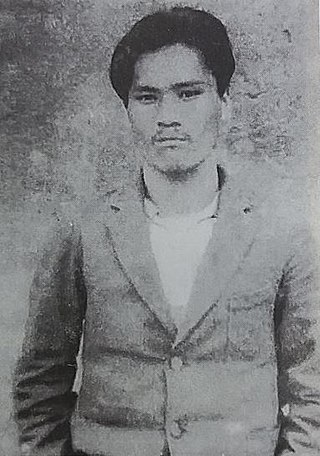
Yun Bong-gil was a Korean independence activist. His art name is Maeheon (매헌).
This article is concerned with the events that preceded World War II in Asia.

The January 28 incident or Shanghai incident was a conflict between the Republic of China and the Empire of Japan. It took place in the Shanghai International Settlement which was under international control. Japanese army officers, defying higher authorities, had provoked anti-Japanese demonstrations in the International Settlement following the Japanese invasion of Manchuria. On January 18th, five Japanese Buddhists in Shanghai belonging to the Nichiren sect allegedly shouted anti-Chinese, pro-Japanese nationalist slogans in Shanghai. In response, a Chinese mob formed killing one monk and injuring two. In response, the Japanese in Shanghai rioted and burned down a factory, killing two Chinese. Heavy fighting broke out, and China appealed to the League of Nations. A truce was finally reached on May 5, calling for Japanese military withdrawal, and an end to Chinese boycotts of Japanese products. It is seen as the first example of a modern war waged in a large city between two heavily equipped armies and as a preview of what was to come during the Second World War.

Japanese militarism was the ideology in the Empire of Japan which advocated the belief that militarism should dominate the political and social life of the nation, and the belief that the strength of the military is equal to the strength of a nation. It was most prominent from the start of conscription after the Meiji Restoration until the Japanese defeat in World War II, roughly 1873 to 1945. Since then, pacifism has been enshrined in the postwar Constitution of Japan as one of its key tenets.

The Port Arthur massacre took place during the First Sino-Japanese War from 21 November 1894 for three days, in the Chinese coastal city of Port Arthur, when advance elements of the First Division of the Japanese Second Army under the command of General Yamaji Motoharu (1841–1897) killed somewhere between 2,600 civilians and 20,000 people including Chinese soldiers, although one eyewitness reporter estimated a total death toll of 60,000, including civilians, soldiers, and residents of the outlying rural district.

Sun Yuanliang was a Chinese military general of the National Revolutionary Army of the Republic of China. Sun was the last surviving member of the first graduating class of the Whampoa Military Academy, as well as the last surviving army-level commander of the Second Sino-Japanese War. His career spanned the January 28 Incident, Second Sino-Japanese War and the Chinese Civil War.
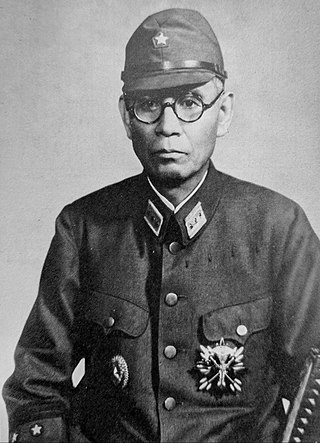
Yasuji Okamura was a general of the Imperial Japanese Army, commander-in-chief of the China Expeditionary Army from November 1944 to the end of World War II, and appointed to surrender all Japanese forces involved in the China Burma India theater. He was tried but found not guilty of any war crimes by the Shanghai War Crimes Tribunal after the war. As one of the Imperial Japanese Army's top China experts, General Okamura spent his entire military career on the Asian mainland.

Cai Tingkai was a Chinese general.

The Empire of Japan's Kwantung Army invaded the Manchuria region of the Republic of China on 18 September 1931, immediately following the Mukden incident, a false flag event staged by Japanese military personnel as a pretext to invade. At the war's end in February 1932, the Japanese established the puppet state of Manchukuo. The occupation lasted until mid-August 1945, towards the end of the Second World War, in the face of an onslaught by the Soviet Union and Mongolia during the Manchurian Strategic Offensive Operation.
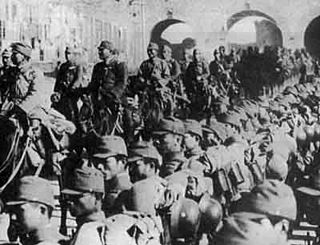
The Shanghai Expeditionary Army was a corps-level ad hoc Japanese army in the Second Sino-Japanese War.

The Marco Polo Bridge incident, also known as the Lugou Bridge incident or the July 7 incident, was a battle during July 1937 in the district of Beijing between the 29th Army of the National Revolutionary Army of the Republic of China and the Imperial Japanese Army.

Following their defeat in the Chinese Civil War, on December 7, 1949, the remnants of the Nationalist government of the Republic of China (ROC), alongside many refugees, retreated to the island of Taiwan (Formosa). The exodus is sometimes called the Great Retreat in Taiwan. The Nationalist Kuomintang party (KMT), its officers, and approximately 2 million ROC troops took part in the retreat, in addition to many civilians and refugees, fleeing the advance of the People's Liberation Army (PLA) of the Chinese Communist Party (CCP). The CCP, who now effectively controlled most of mainland China, spent the subsequent years purging any remnant Nationalist agents in western and southern China, solidifying the rule of the newly established People's Republic of China (PRC).